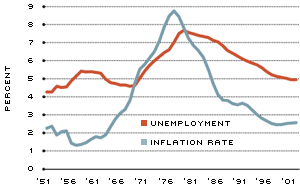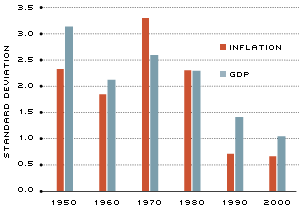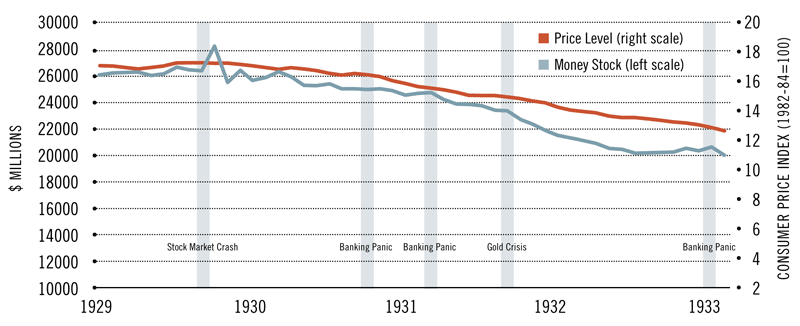Stable Prices, Stable Economy: Keeping Inflation in Check Must Be No. 1 Goal of Monetary Policymakers
The Federal Reserve Act as amended in 1977 directs the Federal Reserve to pursue monetary policy to achieve the goals of "maximum employment, stable prices and moderate long-term interest rates." The Federal Reserve and all central banks have also long been expected to promote financial stability. Specifically, central banks have been expected since the 19th century to serve as lender of last resort to the banking system by providing liquidity to prevent financial crises and disruptions in the payments system.
Are the goals of maximum employment, stable prices, moderate interest rates and financial stability compatible with one another? Many people believe that they are not. Conventional wisdom holds that if monetary policy is too focused on controlling inflation, for example, then employment and output growth will likely fall below their potential, and financial markets will be less stable than they otherwise could be.
The idea of stepping on the monetary gas pedal to boost employment and output growth, or to protect against financial losses, may seem appealing. Indeed, until recently, many economists believed that moderate inflation makes the economy perform better. However, a growing number of economists today believe that monetary authorities can best promote financial stability and economic growth by making a firm commitment to maintaining price stability. There is little evidence that expansionary monetary policy can increase employment or economic growth, except perhaps for brief periods, and there is no evidence that inflation fosters financial stability. On the contrary, history is full of examples of how an unstable price level can wreck a financial system and harm the economy.
Two Views about Inflation
On the subject of inflation, most economists fall into one of two camps. One camp believes that moderate inflation helps promote full employment, economic growth and stable financial markets. Inflation is seen as enabling labor and product markets to function more smoothly in the face of shocks that could otherwise reduce employment or output. Some in this camp believe that central banks can boost employment and output growth more or less permanently by allowing the inflation rate to rise.
The first camp had its heyday in the 1960s. At that time, the data suggested the existence of an exploitable tradeoff between inflation and unemployment—the so-called Phillips Curve, named after the economist A.W. Phillips, who first documented that the unemployment rate and changes in wage rates moved in opposite directions in the United Kingdom.
The Phillips Curve made monetary policy-making seem beguilingly simple. Choose a little more inflation, and unemployment would fall; accept somewhat higher unemployment, on the other hand, and inflation would be a bit lower. Policymaking was viewed as simply a matter of selecting from among a menu of inflation and unemployment options.
Several influential economists argued that this menu could be improved upon if policymakers were willing to discard their old-fashioned obsession with price stability. Allow some inflation, these economists argued, and the labor market would operate more efficiently, employment would rise and the economy would grow faster.
There were some notable dissents from this view. Milton Friedman and Edmund Phelps, both of whom later were awarded the Nobel Prize, argued that inflationary policies do not boost employment or economic growth in the long run. Instead, attempts to use monetary policy to engineer higher employment or faster growth result in ever higher inflation but no more employment or growth than was possible with a stable price level, they said.
Events also put a dent in the arguments of the first camp. Inflation began to rise in the mid-1960s, and it climbed still higher and became more volatile in the 1970s. Higher inflation did not bring about higher employment or faster growth, however. On the contrary, as shown in Figure 1, the unemployment rate was higher on average during the 1970s than it had been during the 1950s and 1960s. The unemployment rate fell in the 1980s and 1990s, albeit slowly, as inflation came down.
The Benefits of Price Stability
Under the weight of persuasive reasoning and empirical evidence, many economists abandoned the first camp and joined a growing second camp of economists, who believe that central banks can best promote high employment and economic growth, as well as financial stability, by focusing on the goal of price stability.
"Price stability" is usually interpreted to mean a low and stable rate of inflation maintained over an extended period of time. In our view, the ideal rate of inflation is zero, properly measured. Biases in price indexes imply that, in practice, price stability will likely be consistent with a small positive rate of measured inflation, say 0.5 to 1 percent, depending on the specific price index one looks at.1 Further, price stability does not mean that the price index is constant. Monetary policy could never eliminate every wiggle in the inflation rate; nor should policymakers try to do so.
Price stability means that inflation is sufficiently low and stable so as not to influence the economic decisions of households and firms. When inflation is low and reasonably stable, people do not waste resources attempting to protect themselves from inflation. They save and invest with confidence that the value of money will be stable over time.
In a market economy, consumers and firms base their consumption and investment decisions on information derived from prices, including asset prices and returns. Efficient allocation of economic resources depends on the clarity of signals coming from the price system, as well as the clarity of signals from governments and central banks about economic policy.
Uncertainty about the price level makes it difficult for firms and households to determine whether changes in individual prices reflect fundamental shifts in supply and demand or merely changes in the overall rate of inflation. By eliminating this uncertainty, a monetary policy that maintains long-run price stability eliminates a potential drag on the efficient allocation of resources and, hence, on economic growth.
Long-run price stability contributes to financial stability in a similar fashion. An unstable price level can lead to bad forecasts of real returns to investment projects and, hence, to unprofitable borrowing and lending decisions. Unexpected bouts of inflation, for example, tend to encourage optimistic forecasts of real returns. Errors in distinguishing nominal and real returns result in misallocation of resources and eventually to financial distress that would not occur if the price level was stable. Business decisions based on expectations of continuing inflation often turn out badly when inflation falls, resulting in higher default rates and business failures. Outright deflation is particularly notorious because a falling price level increases the real cost of servicing outstanding debt.
Price stability is the most powerful tool the central bank has to promote economic growth, high employment and financial stability. Price stability also enables monetary authorities to pursue secondary objectives, including the reduction of fluctuations in real economic activity and the management of financial and/or liquidity crises. These are referred to as secondary goals because a central bank is unlikely to succeed at limiting fluctuations in economic activity or containing financial crises unless the price level is stable.
Lessons from U.S. Economic History
Recent experience supports the view that price stability contributes to financial stability and economic growth. Since the mid-1980s, the United States has seen a reduction in the volatility of both output growth and inflation in an environment that closely approximates price stability. As shown in Figure 2, the variability of both real GDP growth and inflation reached postwar lows during the 1990s and first six years of the 2000s. Further, while there have been temporary financial upsets associated with various shocks, such as the Sept. 11, 2001, terrorist attacks and, more recently, increased defaults in the subprime mortgage market, these events have had little impact on the economy as a whole.
With inflation expectations well-anchored, the Fed has been able to provide liquidity in response to financial disruptions without causing uncertainty about the long-run goals of policy. This confidence in the Fed has probably made such interventions more effective than they would otherwise have been.
Conclusion
The inflation record of the United States and many other countries over the past 20 years has been far better than it was from the mid-1960s to the early 1980s. The recent period has also had a better record of economic growth and financial stability than the preceding years of high and highly variable inflation. Both logic and history suggest that low and stable inflation has contributed to improved real growth and financial stability.
Low inflation and well-anchored inflation expectations have also likely enhanced the Fed's ability to respond to the declines in output growth and financial upsets that have occurred. The Fed responded aggressively to encourage economic recovery from the 2001 recession. The Fed's interest rate cuts did not trigger widespread fears of higher inflation because the public had confidence in the Fed's commitment to price stability. If expected inflation had risen, long-term interest rates would likely have risen and hampered efforts to encourage economic recovery. Hence, price stability likely made the Fed's easing more effective than it otherwise would have been.
Financial markets have confronted a number of shocks in recent history, including the Asian financial crisis and Russian government bond default in 1998, the terrorist attacks of 9/11 and, more recently, the increase in subprime mortgage defaults in 2007. Each time, the Fed quickly provided additional liquidity, and the financial disruptions were contained. Again, well-anchored inflation expectations likely made the Fed's job easier and kept these shocks from having a more serious impact on the economy.
Under the Federal Reserve Act, the Fed operates with a dual mandate to encourage maximum employment and price stability, as well as to act as lender of last resort to the banking system. These goals are not incompatible but fundamentally the same goal. Maintaining low and stable inflation is central to achieving maximum employment and the highest possible rate of economic growth. Price stability also tends to promote financial stability and enhance the central bank's ability to respond to financial disruptions that do occur. Maintaining price stability does not require that the central bank come down hard on every uptick in the inflation rate, but a disciplined response is required when the inflation rate threatens to rise in a sustained fashion or to fall into deflation.
Central bankers need to apply their best judgment—and they will not always be correct in those judgments. But if they have a good record, and if the public retains confidence that the central bank will correct its mistakes, errors in judgment will not do lasting damage.
Figure 1
U.S. Inflation and Unemployment Rates
10-Year Centered Moving Averages

SOURCE: Bureau of Labor Statistics
At one time, some economists, as well as others, thought that a bit of inflation would be good for the economy, raising employment in particular. The data show the opposite cause and effect, however. The figure plots the civilian unemployment rate and the inflation rate, which is calculated as the annual percentage change in the all- items Consumer Price Index.
Variability of Inflation and GDP Growth
Standard Deviation of Annual Data

SOURCES: Bureau of Economic Analysis and Bureau of Labor Statistics
Since 1990, inflation and output growth have been only about half as volatile as they were during the preceding postwar decades. The figure plots the standard deviations of real GDP growth and inflation, which is calculated as the annual percentage change in the all-items Consumer Price Index. Data for the 2000s are for 2001-2006.
Endnotes
- These biases arise from the difficulty of capturing improvements in the quality of goods and services, as well as substitutions among products that comprise consumers' total purchases. Differences in how price indexes are put together imply that the specific rate of inflation that is consistent with price stability will likely vary across countries and over time. For the United States, zero true inflation likely translates to an annual rate of increase in the CPI of about 1 percent and in the broader price index for personal consumption expenditures of about 0.5 percent. [back to text]
- See Robert Barro (1996) and Michael Bruno and William Easterly (1996) for cross-country empirical evidence on the impact of high inflation on economic growth. [back to text]
- Although many economists believe that deflation was an important cause of the Great Depression, some remain unconvinced. See Parker (2007) for a survey of research on the causes of the Great Depression. [back to text]
- See Kane (1989). [back to text]
References
Barro, Robert. “Inflation and Growth.” Federal Reserve Bank of St. Louis Review, Vol. 78, No. 3, May/June 1996, pp. 153-69.
Bruno, Michael; and Easterly, William. “Inflation and Growth: In Search of a Stable Relationship.” Federal Reserve Bank of St. Louis Review, Vol. 78, No. 3, May/June 1996, pp. 139-46.
Friedman, Milton. “The Role of Monetary Policy.” American Economic Review, Vol. 58, No. 1, March 1968, pp. 1-17.
Friedman, Milton; and Schwartz, Anna J. A Monetary History of the United States, 1867-1960. Princeton, N.J.: Princeton University Press, 1963.
Kane, Edward J. The S&L Insurance Mess: How Did it Happen? Washington, D.C.: The Urban Institute Press, 1989.
Parker, Randall E. The Economics of the Great Depression: A Twenty-first Century Look Back at the Economics of the Interwar Era. Cheltenham, U.K.: Edward Elgar, 2007.
Phelps, Edmund S. “Phillips Curves, Expectations of Inflation and Optimal Unemployment over Time.” Economica, Vol. 34, No. 135, August 1967, pp. 254-81.
Phillips, A.W. “The Relationship between Unemployment and the Rate of Change of Money Wages in the United Kingdom 1861-1957.” Economica, Vol. 25, No. 100, November 1958, pp. 283-99.
Views expressed in Regional Economist are not necessarily those of the St. Louis Fed or Federal Reserve System.
For the latest insights from our economists and other St. Louis Fed experts, visit On the Economy and subscribe.
Email Us



